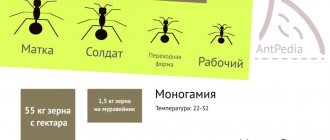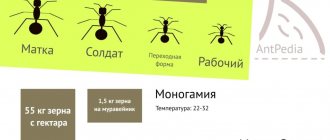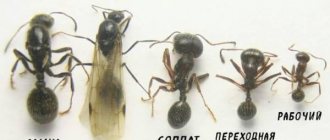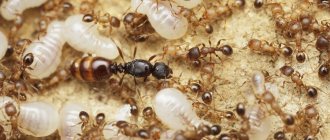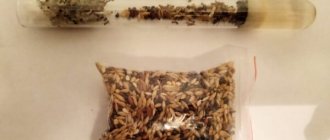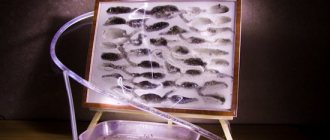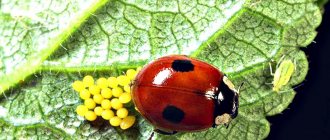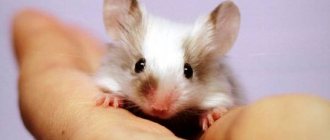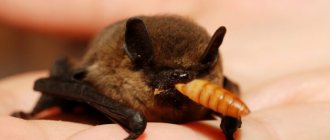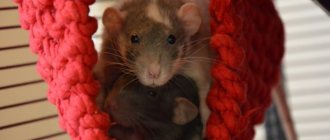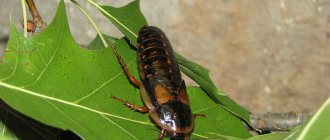Creating an ant farm at home or office is becoming increasingly popular. Unpretentious harvester ants are best suited for this. Before getting these insects, it is worth familiarizing yourself with their species characteristics: way of life, habitat, exterior, characteristics of reproduction and maintenance.
Brief information
Name in Latin: Messor structor Difficulty: for beginners Size of individuals: M - workers from 4 to 9 mm, soldiers up to 11 mm, queen up to 12 mm Size of colonies: up to 5,000 individuals Habitat: steppes and semi-deserts, from Portugal to Kazakhstan, and south to Iran Temperature: 23-25 degrees, preferably warmed up Humidity: gradient, from 30% in the arena to 90% in the nest Diet: plant seeds, dead insects Wintering: not required
What to feed harvester ants?
Until the workers appear, the queen does not need food. It’s better to disturb her less so as not to cause stress. Complementary feeding begins when the first babies appear.
In nature, harvester ants primarily eat grains and plant seeds. Now there are enough online stores that sell ready-made food for Messor structor. You can also try food for small birds. Select several seeds from the bag and observe the insects. This way you can determine what exactly they prefer.
To feed the reapers, they use poppy, millet, meadow grass seeds, rolled oats, and corn. In addition to plant foods, you need to give protein. It is necessary for the larvae. Forage insects can be used to feed the harvester ants, but they need to be crushed a little before being placed in the arena. Usually, one or two larvae per week is enough.
General information about the genus Messor
The genus Messor includes 110 species of ants adapted to life in the desert zone on almost all continents. Thus, 30 species live in Europe alone, 5 of them in Russia. This:
- Messor aciculatus;
- Messor denticulatus;
- Messor kasakorum;
- Messor rufitarsis;
- Messor constructor.
The genus received the name Messor (reaper) due to the method of collecting grain from the fields. The specificity of nutrition is determined by the nature of vegetation in the desert climate. According to research, ants from one family are able to bring up to 1.5 kg of grain to underground storage facilities. The answer to the question: is the harvester ant a pest that steals the fruits of human labor should be answered in the negative. He harvests his harvest only from the ground, from already damaged spikelets. The grains are stored in moist underground chambers for a long time and periodically germinate. Then the ants chew off the seedlings, and the seeds themselves are ground into powder, moistened with saliva and fed to the larvae.
Reaper ants have their own characteristics:
- large size of individuals;
- peacefulness;
- swarming, nest building in spring.
Let us consider this genus in more detail using the example of the species Messor structor (steppe harvester ant).
Biology
Stoyanov et al. (2015) — Messor constructor
are harvester ants storing seeds in underground granaries.
Being major seed consumers in xeric habitats they influence the vegetation by depleting and dispersing seeds (Azcarate, Peco 2003, MacMahon et al. 2000, Schlick-Steiner et al. 2005). According to Seifert (1996), Central European populations of the harvester ant genus Messor are currently considered to constitute a single species Messor constructor
.
It has been reported that M. constructor
ants live mainly in polygynous colonies and could be members of unicolonial populations (Schlick-Steiner et al. 2005).
Messor constructor
is one of the most widespread steppe species. It is well adapted to different conditions and occurs in all of Europe. In Bulgaria this ant is found all over the country in medium-sized populations and occur in plain desolate terrains, mountainous slopes, outskirts of mixed woodland zones and in open well-drained areas such as abandoned fields, pastures, and overgrown laws.
This study examined genetic variability among populations of Messor constructor
from various localities (n=36 nests) in from Southern Bulgaria using isoenzymic analysis. Three of the four enzyme loci used were found to be polymorphic. Observed and expected heterozygosities (Ho and He) ranged from 0.0 to 0.111 and from 0.168 to 0.372, respectively. Nei's (1972) genetic distance was found to range from 0.001 (between Boliarino and Lubenova mahala) to 0.462 (between Chirpan and Merichleri). The estimated mean F-IS and F-ST values from isozyme data were 0.8738 and 0.1432, respectively. Two of the studied populations were grouped separately in dendrograms as compared to all other populations which formed a large cluster consisting of three sub-clusters.
mtDNA. Thirty-one haplotypes of COI (1375 bp) known; (GenBank).
Description and features of the Messor constructor type
The steppe harvester ant is the largest among other ants of the subfamily Myrmicinae. The color is dark, reddish-brown. The length of the working insect varies from 4 to 9 mm, the queen – up to 11-15 mm. The body consists of three parts: head, chest, abdomen, connected to each other by jumpers, due to which insects are flexible and mobile. The massive square head of the ant is equipped with jaws-mandibles, which, when bitten, close like a trap. This is convenient for carrying food and crushing grains.
USEFUL TO KNOW : This is interesting: the terrifying jaws of the harvester ant are not an attack weapon, but a device for processing grain.
Ants are clumsy and slow; When irritated, they choose to run away. The species is characterized by sexual polymorphism, that is, the presence of different forms of individuals: females, males, workers, soldiers and transitional forms. Each category of harvester ants performs its duties.
When studying the question of how long harvester ants live, information was obtained that the worker lives up to 3-5 years, and the queen lives up to 20 years.
Reapers live in families of up to 5,000 individuals. The ground part of the anthill looks like a hole, surrounded by a rampart of earth and debris from the grains brought in. Under the ground, the nest looks like an extended vertical tunnel, with passages with cameras running off the sides. The family has been using one house for several years.
Development timeframe
- Egg - 2-3 weeks
- Larva 1-3 weeks (large 2-3)
- The pupa is 2-3 weeks old, depending on the size. The adult appears 4-5 days after complete pigmentation of the pupa.
- Lifespan. Workers live up to 3 years, microgins - from six months to a year. Sexually mature female Messor sp. lived in laboratory conditions for 25 years.
- The appearance of females and males. Full-fledged females develop with a number of 400-500 workers, males - from 1000-1500. It is possible that females and males appear earlier, but they are quickly killed and eaten.
How is an anthill organized?
Up to 5 thousand individuals can live in an anthill
In a colony of harvester ants there is a strict hierarchy: each family member is busy with his own business. The family consists of a queen - she produces offspring, soldiers - they protect the anthill from dangers and help with harvesting, worker ants - they are engaged in obtaining food and caring for the young. There are also males and females - they mate with each other, creating new colonies.
From the outside, the anthill's shape resembles a volcano
The ground part of the ants' home is a hole in the soil, along the edges of which there is a shaft of earth and debris from the prey they bring. The underground part has a vertical tunnel, from which passages with cameras extend on the sides. In these rooms, ants set up pantries for storing food and “children’s rooms” in which they store larvae.
Habitat
The steppe harvester ant is a resident of the steppes and deserts. Its nests can be found in the countries of the Mediterranean coast, Southern and Eastern Europe, the Caucasus, Middle and Central Asia, Afghanistan, Iran, Iraq, Lebanon, Syria, and Israel. On the territory of Russia, in the Republic of Tatarstan, the species is included in the Red Book due to the threat of extinction.
Years
Reapers are ants of deserts and steppes. Such a life developed an interesting feature in them. Almost all species of ants we encounter raise young males and females in the spring, so that by the end of spring or summer they can fly away and give rise to new colonies. The Messors have a completely different strategy: young individuals capable of reproducing are raised not in May, but in August. Next, the winged generation overwinters in its native anthill and flies out by the end of April. At a time when the queens of other ants are still in the larval state, messoras are already beginning to raise the first generation of new workers. It would seem, why such oddities? The answer is simple: in steppes and semi-deserts, the most favorable conditions for the creation of new colonies appear in the spring, when the average daily temperature is not so high and soil moisture remains.
Ant - protector of forests, gardens and human health
Ants are frequent guests in garden plots. They bring both benefit and harm, so most often gardeners and gardeners try to get rid of them in every possible way. However, before you start fighting them, it’s worth knowing that ants have a lot of useful qualities. The importance of the ant in nature is very great.
- Why are ants needed in the forest?
- Why are ants useful in the garden?
- Treatment
- Photo
- Useful video
- Useful materials
The status of the ant in relation to the forest is very high. Everyone knows from school that you should not destroy ants’ nests. These insects are protected by the state and are specially dispersed artificially to new places.
These insects are the most useful inhabitants of forests.
With their usefulness, they even earned the title “the ants of the forest.”
What benefits do ants bring to the forest? Ants that settle in dead wood accelerate its decomposition, thus freeing the forest from diseased specimens.
These insects are predators and omnivores. During the summer season, the inhabitants of the anthill free the forest from five million harmful insects. This amount frees up a hectare of forest. Of course, birds are also involved in destroying pests, but ants cope with this task more effectively, about 20 times faster.
Ants are seed distributors of many plants. While collecting them and dragging them home, he loses some along the way. This is how plants reproduce throughout the forest area.
Like bees, ants are pollinators for flowers, eating sweet nectar.
By building their underground houses and making numerous passages for their movement, they help loosen the soil. That is why forest plants living above anthills develop most actively. At the same time, in addition to breathability, the soil becomes more nutritious, enriched with organic matter and minerals.
Ants are beneficial insects for songbirds. They take them internally and externally. An ant shower helps birds get rid of parasites. While swimming in anthills, birds tuck insects under their wings and crush them on their feathers.
Why are ants useful in the garden?
Despite some harm caused by insects in the garden, they also have a number of positive properties.
They build their anthills at a depth of one and a half meters, thereby loosening the ground. The soil is mixed at a depth of up to 70 centimeters, raising particles from the lower layers to the surface. At the same time, the soil becomes loose, therefore, it allows air and moisture to pass through better. Plant roots receive more nutrition under these conditions.
Ants increase the nutritional value of the soil because their activity helps remove greenhouse gases from the soil. The soil treated with insects is enriched with minerals. The area above the anthill is ideal for growing all garden crops.
In the soil treated with them, the potassium content doubles, and the phosphorus content increases almost 10 times.
Thus, the presence of black ants in a summer cottage is a sign of good soil quality. They prefer to live in healthy, well-warmed soil. But if they suddenly ran away from your plot, it means that there is something wrong with it and you most likely will not have good results in growing garden crops on it.
Insects actively destroy garden pests. Garden pests: caterpillars, worms, slugs are a real treat for them. Scientists have calculated that the inhabitants of one anthill destroy about two thousand garden pests and their larvae in just one day of summer.
Treatment
The healing properties of ants have been known for a long time. From time immemorial, people have made tinctures and ointments from them. These insects are still used today. The main active ingredient in such preparations is formic acid.
Acid-based drugs help in the treatment of arthritis, rheumatic and atrophic, neuroses, dizziness in old age. They can also alleviate the condition of patients with hepatitis.
Preparations with a hemostatic effect are prepared from ants. Their venom also contains antibiotics that can fight fungal and bacterial infections, including staphylococci and streptococci.
Before you destroy these little workers on your plots, evaluate the benefits they bring.
Next you will see a photo of how ants are used in nature:
Nutritional Features
The feeding habits of reapers have created several transitional forms among worker ants. It takes a lot of effort to grind cereal grains. Thus, the large head of soldier ants is the result of the development of massive occipital muscles, which are responsible for the work of the lower jaw. The prepared seed pieces are processed by smaller worker ants, as it requires less effort. Next, the grains turn into flour and are moistened with saliva. This gruel is fed to the larvae.
In addition, ants also eat animal food: they collect dead insects or organize collective hunts themselves. However, this type of food is secondary.
Progressive Insect Society
The main similarity between ant and human societies is the high dependence of their representatives and the inability to live in isolation. An interesting fact about ants: they, like people, are capable of cooperation and are inclined to share responsibilities, on the basis of which they form strata by type of activity. Their survival as a species over the years has depended not on evolution, but on their commitment to collectivism. This gave entomologists the basis to call multimillion-dollar ant colonies universal “superorganisms.”
Any species is characterized by hierarchy, structuring, caste society and sacrifice. Listing interesting facts from the life of ants for children, I would like to note that the castes of the society of these insects include “workers” and “scouts” (females deprived of reproductive function) who search for and obtain food, as well as soldiers (large individuals with strong mandibles) protecting the colony.
Reproduction
Living conditions even affected the breeding habits of reapers. Most ants raise sexually mature individuals by late spring or early summer. Reapers emerge in late summer, spend the winter in the nest, and begin breeding in April. This gives them the opportunity to build an anthill under favorable conditions, while the steppe soil is not dry and the ambient temperature is not yet so high.
Each harvester ant nest contains one queen. At the stage of nest formation there may be several of them, but then the ants expel or eat the extra ones. The males, having fertilized the female, die.
The harvester ant is an insect with a full development cycle: egg, larva, pupa, adult. The first three stages take up to 2-3 weeks each. Reaper ants are characterized by two methods of reproduction: asexual and sexual. Asexual is represented by parthenogenesis, it leads to the birth of worker ants. In the sexual method, males and females are born.
Introduction
Polygyny is the phenomenon of the existence of several oviparous females (queens) in an ant colony.
The phenomenon often occurs among small species, as well as in species with an increased likelihood of worker mortality. Compared to monogyny colonies, polygyny has a number of advantages, namely greater potential for the initial establishment of a family, high productivity in brood production, subsequent rapid growth and the ability to quickly breed winged reproductive individuals for the subsequent dispersal of the species and a possible increase in the range. Cosmopolitan and invasive species, as well as many dominant species of ants in natural habitats, are polygynous; an example is Messor aciculatus (Smith, 1874) [1, p. 87]. Polygyny is also observed in monogyny species during the initial formation of a new family and the establishment of a nest, when several reproductive females jointly hatch the first workers, but subsequently one oviparous female remains, the others are either destroyed by the workers or leave the nest with some of the workers or, more often, alone. There have been cases where, in the course of selecting a single oviparous queen, workers kill all potential queens. However, sometimes all the queens can survive and remain in the nest, and subsequently, having settled in different parts of the nest and without communicating directly with each other, they are able to serve as an oviparous female [ 2–5
]. This phenomenon is called oligogyny.
The key factor influencing the formation of polygyny and monogyny in a colony is the pheromones of oviparous females. In species with polygyny, pheromones (pheromone marks, markers, aromatic communication) do not play an important role in the family’s determination of the dominant queen; they only notify the worker ants about her health and reproductive potential [ 6; 7
]. In species with monogyny, pheromone markers play a significant role in establishing the dominant oviparous queen and alerting workers to submission and elimination of competition. However, pheromones, like other volatile chemicals, are subject to changes in activity with changes in concentration in the air and temperature fluctuations [
8; 9; 2
].
Confirmation of the theory about the relationship between the size of the initial nest and temperature on the formation of polygyny in colonies with a monogynous family structure was the main goal of the experiment.
Maintenance and care at home
Both experienced myrmikeepers and beginners can keep and care for ants. Having created comfortable conditions, there is practically no need to care for the reapers. With a supply of water and food, the ant farm can easily tolerate the absence of humans for several weeks. In addition, they are peaceful and do not require wintering.
Start of the colony
Since the queen establishes a colony on her own, the standard colony raising scenario is used. The queen is placed in an incubator and removed to a dark place until the first workers appear.
Incubator, Formicarium, Arena
Incubator
For a starting colony, a standard incubator made from a test tube or syringes is used. Subsequently, as the number increases, a feeding arena is attached to the incubator. You can also install an additional dry tube for storing seeds.
Formicarium
It is recommended to keep Reapers in gypsum and aerated concrete formicariums, preferably horizontal type, this is due to the need for large areas for grain storage. A good example of such a farm is the Jungle formicarium. In formicaria of this type, a humidity gradient is formed - in dry chambers the ants will store seeds, in wet chambers they will germinate seeds, in chambers with moderate humidity the majority of ants live, brood will be stored, etc. Humidity gradient is extremely important for reapers! When pouring a formicarium slab, you need to take into account that reapers are very good at chewing plaster. This problem can be solved by adding cement to the mixture, thereby increasing the strength of the slab. If you do not do this, it is necessary to place the cameras and passages further from the communications of the formicarium. Especially from the humidification chamber, otherwise the ants may gnaw a tunnel to the water and cause flooding.
Arena
It is not recommended to use sand or earth as soil - the ants will cover the glass in the formicarium with it, reducing visibility to almost zero, and, moreover, they will regularly block the entrance. You can either just leave the plastic (glass) or fill the arena with a thin layer of plaster. Systematic cleaning of the arena is mandatory! Reapers, due to their specific diet, produce a lot of organic debris (husks), which can rot and cause mold. It is necessary to place a drinking bowl in the arena (at least a piece of a syringe with cotton wool).
Buying ants and tips for choosing a farm
You can buy harvester ants for the formicarium in a special online store. The cost is quite affordable - approximately 900 rubles. Most often, a colony includes 10 workers and one queen. Some stores offer the opportunity to choose a family - there are options of 50 individuals.
Usually, for a home ant farm, it is recommended to purchase harvesters, since they are large in size and not very demanding when it comes to food.
Harm caused
The Reaper is beneficial only in virgin steppes, as it promotes the spread of seeds of various plants. But if such goosebumps appear near the currents where grain is threshed, they can cause serious damage to the future harvest. The harvester ant never attacks a person first. But in case of danger it bites painfully. Schmidt compared their bite to the feeling you would get if you were picking out an ingrown toenail with a drill.
Having settled in the home, pests often penetrate into household appliances, computers, and air conditioners, causing problems in their operation. Reapers can actually be found under baseboards, in the space between ceilings, in kitchen cabinets, under old wallpaper that is peeling away from the wall in some places. Living in human habitation, reapers eat bread, cereals, butter, sugar, meat, fruits, and vegetables. They are capable of chewing clothes made from natural material, leather book bindings, wallpaper paste, paper, cardboard, cellophane (if anything edible is wrapped in it).
Red ants sometimes damage the insulating winding with their powerful jaws, resulting in electrical short circuits and fires.
Source
Where do ants live
These insects are distributed almost all over the world; they are not found only in areas covered with eternal glaciers and in ocean spaces. They learned to amazingly adapt to the most difficult living conditions, even deserts and cold northern regions were no exception.
To build an anthill you can use:
- tree;
- a cavity in the ground;
- human dwelling.
Sometimes hardworking insects build their own homes. Where ants live depends on their species. For example, blacks prefer to build their homes in the ground or in rotten wood. Redheads make anthills under stones or tree trunks torn out by the wind. Forest people build impressive “mansions” in size, which can be more than 2 meters in height. Pharaohs prefer a humid climate and the proximity of human habitation, so they often become inhabitants of ventilation ducts, spaces behind the baseboards, and even furniture. Individual colonies take over other people's homes.
Foraging for food
For a long time it was believed that messor constructor ants were agricultural pests, since large reserves of wheat, barley, millet, and millet grains were found in their anthills. Later, it became known what ants eat and how they collect seeds.
Interesting!
Numerous chambers for storing grain are built in the anthill. In one season they can collect up to 50 kg of grains. An insect can eat all this in one season. In tropical countries, abundant ant stocks are often the subject of controversy. Who owns the found grain - the owners of the field where the anthill is located, or the owner of the land from where the reapers carried the harvest.
A family of ants sends different numbers of messengers in search of food. How many are required depends on the speed at which the sent family members return. If there is a lot of harvest, the ants return quickly and bring large supplies.
In distress, the ant is absent from the fields for a long time; after its return, fewer individuals are sent to the fields. Gradually reducing the number to zero.
Larval development
Individuals take care of the eggs, move them to separate chambers, and ensure that favorable conditions are maintained. Division into castes occurs already during the hatching of the larvae. Which of them will be who in society depends on the amount of food consumed.
The larvae are not able to move or eat independently. All this is provided by breadwinners and caregivers. The young are constantly increasing in size and pupate after 1-2 months. The pupa does not have a dense shell; the development of insects can be monitored. At the last stage, it begins to move and a full-fledged insect appears.
